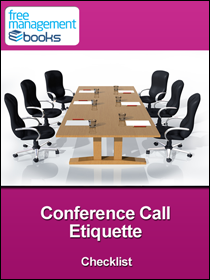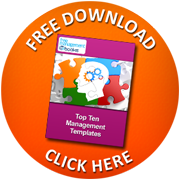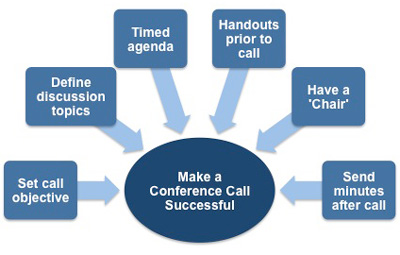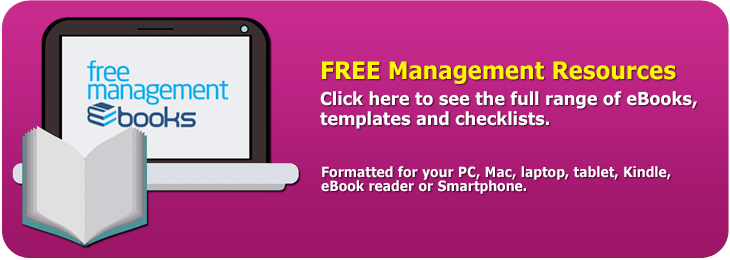Conference Call Etiquette Checklist
 |
 |
|
 |
||
The use of conference calls is increasing as organization's need to communicate with different business units working in different time zones. Employee’s often find themselves having meetings outside the traditional working day to take the time differences into account.
Organization’s need to ensure that the individual’s all have the same level and quality of technology. The increasing capabilities of mobile phones to make conference calls has greatly eased the equipment and technology burden.
![]()
![]()
There are several apps and services you can use:
- Skype - enables you to easily set up group chats. Everyone can be a Skype user or you can have credit to call landlines. It can be used on Macs, PCs, iPhones, smartwatch and Androids.
- Voxeet - is a free app for iPhone and Androids and can set up free for calls of up to eight people. Its 3D sound speaker recognition with photos of all those on the call appear on your virtual conference table, removing confusion as to who is speaking.
- Speek - removes the need for numbers, passwords or pins by users creating their own URL and is free for up to five callers. (iPhones, Androids & Windows can download the app).
- Uberconference - is a conference call app for iPhones and Androids that has a colourful interface and automatic connections to social media. By using its ‘post call summary list’ feature you can see who actively participated in the call.
- Voxer - whilst this app does not offer traditional conference calling it does offer the ability to send spoken messages (like WhatsApp) to an individual or teams (up to 500 people). When used for specific groups of people (repair, house visits, delivery etc) the voice message, text or photo can be picked up when that person is free rather than interrupting them performing their role. (iPhones, smartwatch, Androids & Windows can download the app)
Each one offers different level of abilities to communicate and you may use different ones for different levels of communication from the complex to the purely informative. For example,
Skype is used for meetings/calls needing internal and external people.
Voxer is used to keep service personnel up-to-date on the status of calls or deliveries.
For your organisation’s conference calls to be effective communication and decision making activities it still requires that your users follow a pre-defined set of guidelines. These do not have to be heavily prescriptive but they do need to set expectations of how individuals will behave during such calls. This has become known as ‘Conference Call Etiquette’.
These Etiquette Guidelines need to remind individuals that:
- As with traditional meetings an individual will take on the role of chair, usually the person requesting the meeting and conference calls are no different. Such calls will only be effective and productive uses of peoples times if everyone knows who is Chair of the call. This individual will be responsible for controlling the communications to ensure all items on the agenda are discussed fairly, allowing everyone the opportunity to express their opinion and knowledge.
- Prepare properly for the conference call. Make sure you have the necessary information, reports, data etc. that you will need to have at hand to address the agenda items you know will be discussed. The better you plan for the call by setting an agenda, providing a list of other participants and their roles and organizations as well as sending out any background information, the better everyone involved can prepare and participate. This enables each person to have the notes required and their own comments to hand when that agenda item is being discussed.
- You must actively listen to what is being said to grasp the true meaning of the words spoken. Even if you are able to see a video of the speaker’s face the device you are using may be too small for tiny facial changes to be easily identified.
- Always Identify yourself before you beginning speaking, its good manners and you’d never launch into a face-to-face discussion at a meeting without introducing yourself. It also enables everyone involved in the call to know who you are. They can then ask any questions they may need to clarify your role in the call.
- Before starting a conference call ensure that wherever you are that people know you aren't to be interrupted, your PC screen is off to one side (laptop closed) so you’re not tempted to read emails etc whist on the call. The only way to get a positive outcome is to be 100% focused on the call.
- In terms of the technology there are a few etiquette guidelines:
- Don’t use the hold facility.
- Turn off the call waiting facility.
- Use the mute facility to remove your own background noise when you are not speaking.
- Use the best most up-to date handset available to give you the best quality line during the call. This is becoming less important as more and more conference callers use their own mobile device.
If your role includes dealing with international clients who you cannot easily and speedily meet face-to-face, then conference calls provide you with an efficient and focused means of communication and making decisions.
 |
As the underlying technology improves, many of the technical problems associated with conference calls are becoming less common. However, the intrinsic limitations of the medium mean that most people still find it an uncomfortable way to communicate compared to a face-to-face meeting.
In order to overcome these limitations, every organization that uses conference calling should have a set of published guidelines that cover both the technical aspects and the accepted etiquette of conference calls. If your organization does not have such a thing then you should think about producing something yourself, even if it is only for use within your own project.
Preparation is the key to how successful your conference calls will be. The better you plan for the call by setting an agenda, providing a list of other participants and their roles and organizations as well as sending out any background information, the better everyone involved can prepare. This enables each person to have the notes required and their own comments to hand when that agenda item is being discussed.
You may also be interested in: An Introduction to Conference Calls, Types of Conference Call, Technical Issues Affecting Conference Calls, Human Factor Issues, Maintaining Your Productivity, Adapting Your Communication Style, Advance Planning, Controlling the Call and Conference Call Etiquette.


